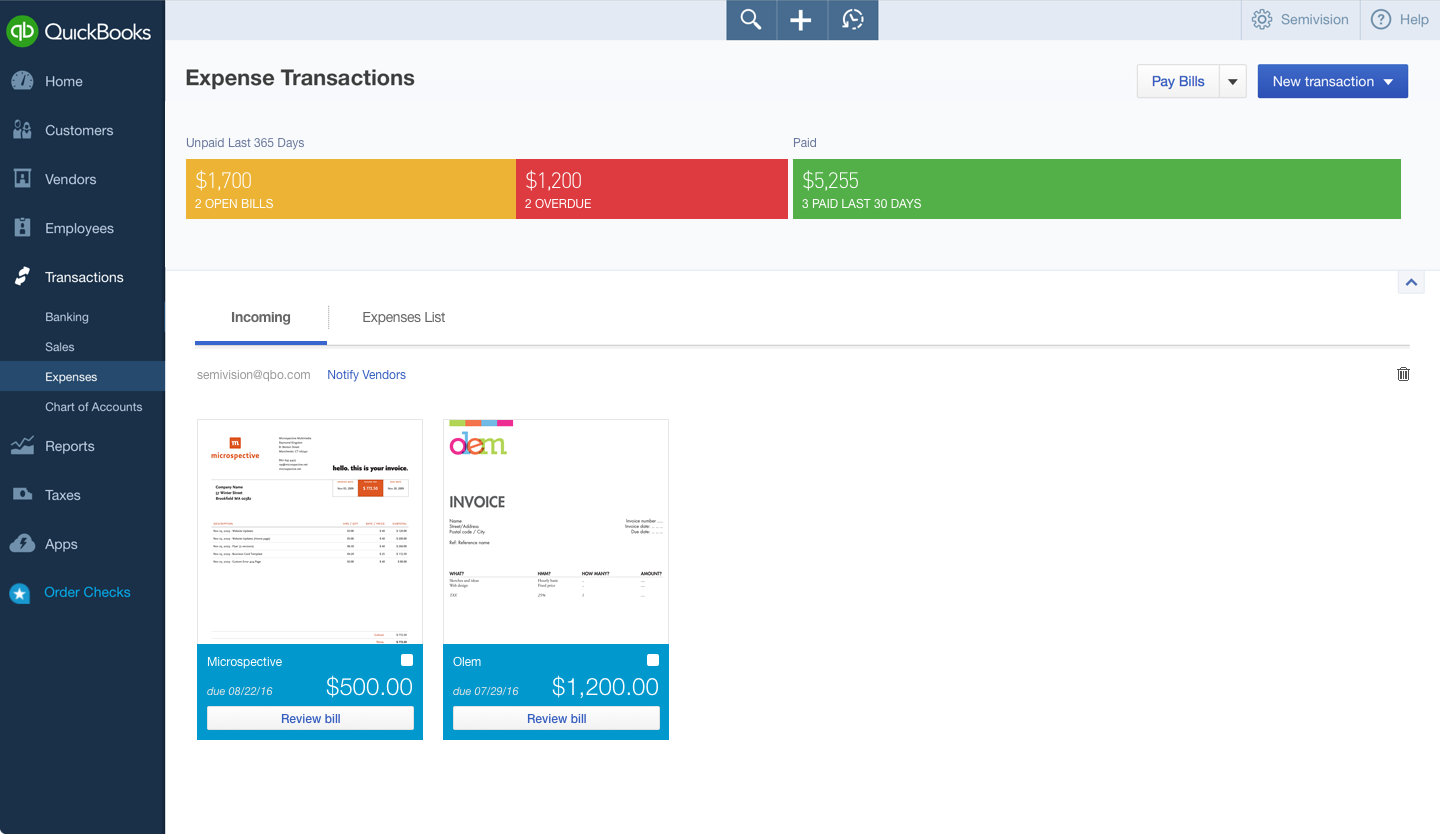For millions of small business owners, bill payment is a very tedious and time-consuming process that takes them away from what matters to them most: focusing on their business. To solve this, Intuit and Bill.com announced a partnership at QuickBooks Connect that will power end-to-end accounts payable within QuickBooks Online in efforts to speed up the bill payment process.
Bill.com has been a trusted QuickBooks Online partner for five years and is already used by many QuickBooks Online small businesses and accountants. Today, Bill.com processes more than 15 million documents and bills through its platform, which equates to approximately $30 billion a year in bill payments. With three of the nation’s top ten banks relying on Bill.com, the company is a perfect partner to take online bill payment to the next level.
“Intuit and Bill.com have had a very close partnership since the beginning, and Bill.com was one of the first partners on Intuit’s app platform when it first launched. As Intuit has put more effort behind its small business platform, Bill.com has been very happy to help and be a part of it,” said René Lacerte, CEO and founder of Bill.com. “Further integrating Bill.com with the QuickBooks Online platform helps us deliver on our mission to make it simpler for small businesses to execute on the payables they have.”
“The integration with Bill.com is all about easier outbound payments for our QuickBooks small business customers,” said Vinay Pai, head of Intuit Developer Group. “As one of the top apps being used by our customers for outbound payments, we decided to create a deeper and more seamless integration with Bill.com to offer customers a one-stop shop for managing bill payments and their overall accounting needs. A seamless integration is great for Bill.com and Intuit, but it’s really the customers who win.”
According to Lacerte, 90 percent of bill payments are still being made via check because of the misconceived notion that it creates a paper trail that makes it easier for businesses to track documents and workflow. The truth is that Bill.com digital transactions provide much more organization. Users can automatically receive information, such as payment status, digitized check images and date and time stamps.
Digital payments are also a money-saver. The average cost for a small business to pay a bill – including the cost of routing, approval, writing the check and storing documents – amounts to $30-$50 per bill. Since many of these vendors and businesses are also on QuickBooks Online, this integration with Bill.com allows users to pay their bills electronically, while still being able to track bill payments. It’s a faster and more affordable process.
Currently, 23 percent of Intuit’s customer base writes checks each week, paying and recording 30 million bill entries from within QuickBooks Online each month. These are high-volume check writers, which means about 23 percent of QuickBooks Online users are appropriate customers for Bill.com. As QuickBooks Online learns more about users, it will recommend Bill.com to those who would benefit from the integration. For users, the experience will look exactly like QuickBooks Online. Bill.com will open up inside QuickBooks Online and provide additional functionality to QuickBooks Online customers. QuickBooks Online will learn from users who are currently using Bill.com and offer that solution to other customers who have a similar profile. Through machine learning and deeper integrations, using QuickBooks Online becomes an even more pleasant experience and more powerful solution for customers.
This integration doesn’t just eliminate pain points for small businesses, but also makes life easier for accounting professionals. Accountants typically find themselves spending a lot of time trying to collect documents to reconcile expenses and codes. With this deeper integration between Bill.com and Intuit, accountants have remote access to all of the information they need. When they log in, they will also be able to see their clients’ Bill.com windows and drill down to see anything their clients have on file. Accountants who have that level of core, fundamental information feel they are in a position to provide more sound advice. In other words, having access to this information enables accountants to confidently step into their role as trusted advisors.
Features of the new deeper integration between QuickBooks Online and Bill.com include the ability to manage electronic payments end-to-end, track bill payments, connect with Bill.com members in the Bill.com network and automatically reconcile transactions within QuickBooks. The integration also creates an in-product experience for the small business customer, eliminating the need for users to work out of two different apps. Bill.com easily tracks and stores payments, so now any small business customer can access all of their Bill.com com data – bills, payments, history, clearance and approvals – from inside QuickBooks Online.
“Intuit is taking their app platform to the next level. One of the biggest challenges for small businesses is finding a solution that contains all of the features they need. It’s a pain point that Intuit is actively addressing with its apps platform. Now, when a QuickBooks Online user gets ready to pay a bill, they will have the option to pay online using Bill.com. This is a natural, unifying experience for 1.5 million QuickBooks Online users,” said Lacerte.
Since one of the top things that customers request is deep integration within QuickBooks Online, the Intuit Developer Group works closely with developers to create a collaborative process that ensures their success in the QuickBooks Online ecosystem. The group aims to make app integration within QuickBooks Online a much more seamless process for the end-to-end customer by looking at how to embed apps natively inside QuickBooks Online, starting with data. As the group continues to work closely with developers, the company is able to offer more solutions to customers. There are now more than 435 apps published on the Apps.com platform, up from 70 at launch just a few years ago.
“With QuickBooks Online integrations, we can offer some of our user interface compartments to third parties, allowing them to present one look and feel to end users. This is a unique capability in the small business market, and as such, we have more than doubled our customer base and witnessed a 10-time growth in app usage in the last two years,” said Pai.
QuickBooks Online’s continuous growth is just one indicator of Intuit’s commitment to the small business, accountant and developer communities. As the company continues to partner with third parties, such as Bill.com, to deliver deeper integrations into its ecosystem, customers can expect to see even more solutions that will streamline their backend processes so they can spend more time focusing on their business.
“QuickBooks Online is a collaborative ecosystem where some of the apps come from Intuit, while most come from third-party developers and strategic partners,” said Pai. “There are many innovative solutions from us and our third-party developer partners. We want to take all of that innovation and deliver it in the best way to help our customers grow and fuel their success. We want QuickBooks Online to be the platform of choice for small businesses, developers and accountants.”
“This integration between Bill.com and QuickBooks Online is a great win for customers. They will have full integration of multiple products, creating a phenomenal user experience. One of the great things about working with Intuit is that both Bill.com and Intuit are focused on creating the best user experience for our customers. When you have two companies that are focused on that, it becomes a unifying experience and end users reap the benefit,” said Lacerte.
The new integration is being rolled out as a limited release this month and will be available for all customers early next year. Visit Apps.com for more information.
Thanks for reading CPA Practice Advisor!
Subscribe Already registered? Log In
Need more information? Read the FAQs




